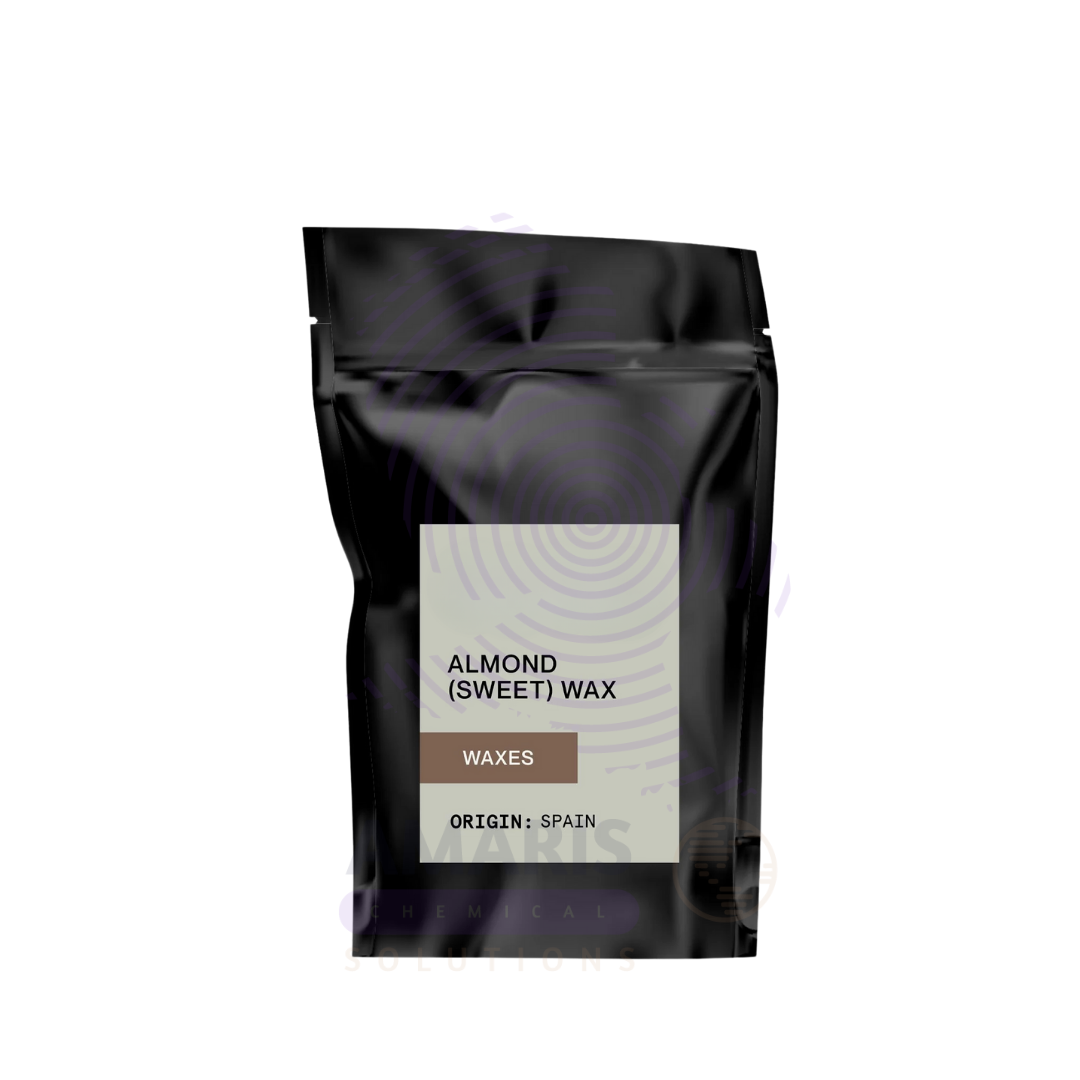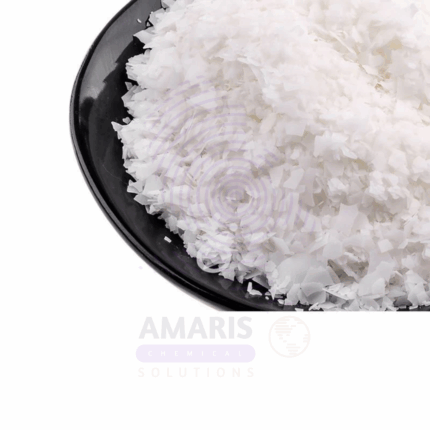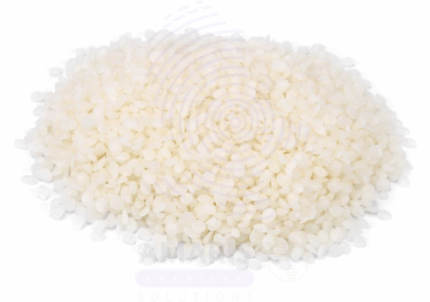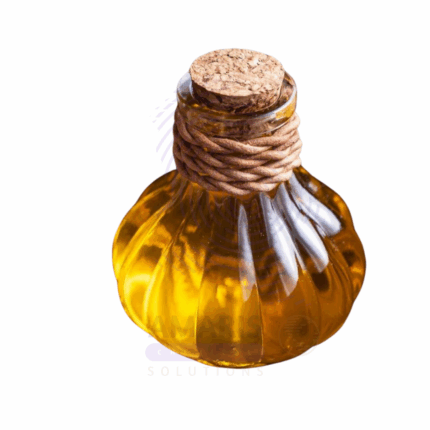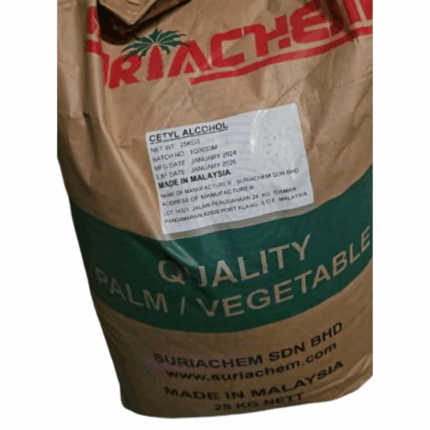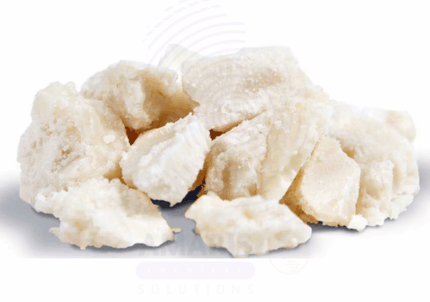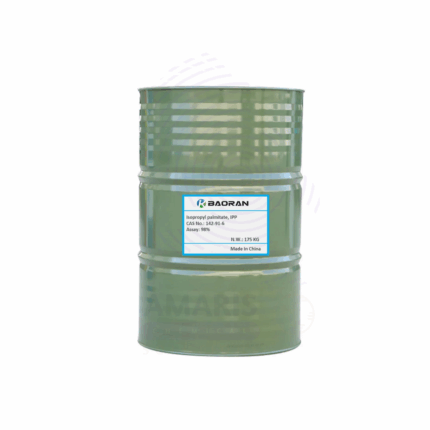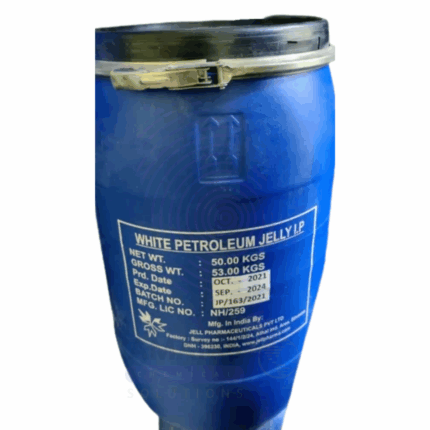
Albendazole Raw Material
$ 4.69 Original price was: $ 4.69.$ 4.58Current price is: $ 4.58.

Aloe Vera Gel
$ 13.66 Original price was: $ 13.66.$ 13.55Current price is: $ 13.55.
Almond Wax
$ 5.20
Whatsapp Order
Almond Wax is a plant-based wax derived from almond oil, typically used in cosmetics and skincare products. It is known for its emollient (moisturizing) properties, helping to soften and smooth the skin. Almond wax is rich in fatty acids and vitamin E, making it suitable for sensitive or dry skin. It is often used as a natural alternative to synthetic waxes in formulations like lip balms, creams, and lotions. Additionally, it provides a smooth texture and helps to stabilize emulsions in skincare products.
Categories: Emollients, Binders/Resins, Thickeners
Tags: Almond Wax, Candle making, Cosmetic formulations, Organic personal care, Skin care products
Description
Table of Contents
Toggle
Almond Wax
Primary Uses
- Cosmetics & Skincare
- Emollient & Moisturizer: Used in lip balms, creams, and lotions for its softening properties.
- Natural Thickener: Adds texture to solid perfumes, deodorants, and makeup (e.g., mascara, brow pomades).
- Vegan Alternative: Replaces beeswax in clean beauty formulations.
- Haircare Products
- Provides hold and shine in hair waxes, pomades, and styling balms.
- Conditions hair while reducing frizz.
- Candlemaking
- Blended with other waxes (soy, coconut) for softer, slow-burning candles.
- Adds a subtle nutty aroma (unrefined versions).
Secondary Uses
- Pharmaceuticals
- Used as a binding agent in ointments and salves.
- Food Industry (Limited)
- Occasionally used as a coating for nuts/fruits to preserve freshness (food-grade only).
- Leather & Wood Polish
- Adds a protective, glossy finish to leather goods and furniture.
- Art & Craft Supplies
- Incorporated into encaustic painting (mixed with pigments).
Additional information
| PACK SIZE |
5kg |
|---|
KEY PRODUCT FEATURES
1. Basic Identification Attributes
- Chemical Name: Prunus amygdalus dulcis (Sweet Almond) wax
- CAS Number: 68917-72-2 (for almond wax) / 8007-69-0 (almond oil)
- HS Code: 1521.90 (Other vegetable waxes)
- Molecular Formula: Complex mixture (primarily fatty acid esters, C40–C60)
- Synonyms:
- Almond peel wax
- Sweet almond wax
- Vegetable wax (almond-derived)
2. Physical & Chemical Properties
- Physical State: Solid flakes or pastilles (soft at room temperature)
- Color & Odor: Off-white to pale yellow; mild nutty aroma
- Melting Point: 45–55°C (softer than beeswax)
- Boiling Point: Decomposes before boiling
- Density: ~0.95–0.98 g/cm³
- Solubility:
- Insoluble in water
- Soluble in oils, chloroform, and hot ethanol
- Acid Value: 5–20 mg KOH/g
- Saponification Value: 80–120 mg KOH/g
- Viscosity: Low melt viscosity (~200–400 cP at 70°C)
3. Safety & Hazard Attributes
- Hazard Class: Non-hazardous (GHS: Not classified)
- NFPA Ratings: Health (0), Flammability (1), Reactivity (0)
- Exposure Limits: No OSHA PEL/ACGIH TLV (food-grade safe)
- Reactivity: Stable; avoid strong oxidizers
- Allergen Potential: Low (but may contain trace proteins; almond allergy warning)
4. Storage & Handling Attributes
- Storage Conditions:
- Cool (<25°C), dry, away from light
- Airtight containers to prevent oxidation
- Incompatible Materials: Strong acids/bases
- Container Type: Food-grade HDPE or glass
- Shelf Life: 2–3 years (unopened)
- Special Handling:
- Melt using gentle heat (<80°C to avoid degradation)
- Standard food-grade PPE (gloves if handling hot wax)
5. Regulatory & Compliance Attributes
- Regulatory Status:
- FDA: 21 CFR 184.1979 (GRAS as a coating agent)
- EU: Compliant with EC/1223/2009 (Cosmetic Regulation)
- COSMOS: Certified for organic cosmetics
- Hazard Symbols: None
- Transportation Restrictions: Non-hazardous (no UN number)
- Waste Disposal: Compostable/biodegradable
6. Environmental & Health Impact
- Ecotoxicity: Low (LD50 > 2000 mg/kg oral, rat)
- Persistence: Readily biodegradable (>60% in 28 days, OECD 301B)
- Carcinogenicity: Not listed by IARC/NTP
- Biodegradability: High (plant-derived esters hydrolyze naturally)
SAFETY HANDLING PRECAUTIONS
Safety precautions
Personal Protective Equipment (PPE)
- Skin Protection: Use gloves (nitrile or latex) to prevent prolonged skin contact, which may cause mild irritation in sensitive individuals.
- Eye Protection: Wear safety goggles when melting or handling hot wax to prevent splashes.
- Respiratory Protection: A dust mask is recommended if handling powdered wax to avoid inhalation.
Handling & Storage
- Storage: Keep in a cool, dry place, away from direct sunlight and heat sources.
- Melting Precautions:
- Use a double boiler or controlled heating to avoid overheating (flammable at high temperatures).
- Avoid open flames—use electric heaters instead.
- Avoid Contamination: Use clean, dry utensils to prevent microbial growth.
Spill Management
- Solid Wax: Scoop up with a clean tool and reuse if uncontaminated.
- Melted Wax Spills:
- Allow to solidify, then scrape up.
- Use paper towels and warm, soapy water for residue.
First Aid Measures
Skin Contact
- Hot Wax Burns:
- Immediately cool with cold running water for 10–15 minutes.
- Do not peel off wax—let it cool and remove gently.
- Apply aloe vera gel or a burn ointment.
- Seek medical help if severe.
- Cold Wax Contact: Wash with soap and water if irritation occurs.
Eye Contact
- Melted Wax Splash:
- Rinse immediately with lukewarm water (not hot) for at least 15 minutes.
- Hold eyelids open to ensure thorough flushing.
- Seek medical attention if irritation persists.
Inhalation
- If wax dust is inhaled, move to fresh air.
- If respiratory irritation occurs, consult a doctor.
Ingestion
- Almond wax is non-toxic but not food-grade unless specified.
- If swallowed, rinse mouth and drink water.
- Seek medical advice if discomfort occurs.
Firefighting Measures
Flammability
- Almond wax is combustible when melted (flash point ~ 200–250°C / 392–482°F).
- Not highly flammable in solid form.
Extinguishing Media
- Small Fires: Use CO₂, dry chemical powder, or foam.
- Large Fires: Use water spray or fog (avoid strong jets that may spread molten wax).
Firefighting Precautions
- Wear self-contained breathing apparatus (SCBA) if heavy smoke is present.
- Do NOT use water jets on molten wax (may cause splattering).
- Cool nearby containers with water spray to prevent re-ignition.
Related products
Almond Wax
Almond Wax is a natural, plant-based wax derived from the hydrogenation of almond oil (Prunus amygdalus dulcis). It is a creamy to white, semi-solid wax with a mild, nutty scent and excellent emollient properties. Almond Wax is rich in fatty acids and has a smooth, soft texture, making it ideal for use in cosmetic, personal care, and candle formulations.
Due to its gentle consistency, skin-friendly profile, and moisturizing capabilities, Almond Wax is widely used in body butters, balms, lip care products, massage bars, and artisan soaps. It functions as a natural alternative to petroleum-based waxes and provides structure, viscosity, and glide to formulations. It also finds application in soft wax blends for natural candle products.
Avocado Wax
Avocado wax is a natural plant-derived wax extracted primarily from the pulp and seed of the avocado fruit (Persea americana). It appears as a hard, yellowish wax with excellent emollient, film-forming, and moisturizing properties. Valued for its biodegradability, compatibility with various formulations, and sustainability, avocado wax is widely used as a natural alternative to synthetic waxes in cosmetics, pharmaceuticals, food, and industrial applications.
Baobab Oil
Baobab Oil is a luxurious, cold-pressed oil extracted from the seeds of the Adansonia digitata (baobab) tree, native to Africa. Rich in omega fatty acids (especially omega-3, 6, and 9), vitamins A, D, E, and F, and powerful antioxidants, Baobab Oil is prized for its deep moisturizing, skin-rejuvenating, and anti-inflammatory properties. It is a light, non-greasy oil that absorbs quickly into the skin, making it ideal for a wide range of cosmetic and personal care applications.
Baobab Oil is especially suited for dry, sensitive, or mature skin. It supports skin elasticity, improves tone, and helps reduce the appearance of scars and stretch marks. In hair care, it nourishes and protects, leaving hair soft and manageable. Its natural stability and skin compatibility make it a premium ingredient in high-performance formulations.
Cetyl Alcohol
Cetyl Alcohol, also known as 1-Hexadecanol or Palmityl Alcohol, is a fatty alcohol derived primarily from natural sources such as palm oil and coconut oil. It appears as a waxy, white to pale yellow solid with a faint fatty odor. Cetyl Alcohol is widely used in cosmetic, pharmaceutical, and industrial formulations due to its emollient, emulsifying, thickening, and stabilizing properties. It helps improve texture, consistency, and moisturizing effects in personal care products. Cetyl Alcohol is compatible with many ingredients, making it a versatile multifunctional ingredient.
Dimethicone Silicon Oil
Dimethicone Silicon Oil, also known as polydimethylsiloxane (PDMS) or silicone oil, is a clear, odorless, and non-volatile silicone-based polymer widely used for its lubricating, anti-foaming, water-repellent, and skin-conditioning properties. It is a linear silicone polymer composed of repeating dimethylsiloxane units. Dimethicone exhibits excellent thermal stability, chemical inertness, and low surface tension, making it highly versatile in pharmaceutical, cosmetic, personal care, industrial, and food applications. It is available in various viscosities, from very low to high viscosity oils, enabling tailored formulations.
Illipe Butter
Illipe Butter is a natural, hard vegetable fat derived from the nuts of the Shorea stenoptera tree, native to the rainforests of Borneo. Known for its high melting point and rich moisturizing profile, Illipe Butter is prized in cosmetic, pharmaceutical, and food applications for its emollient qualities and stability. It closely resembles cocoa butter in composition and function, making it a sustainable alternative in formulations requiring consistency and long shelf life. The butter appears as a pale yellow to off-white solid with a mild, neutral aroma.
Isopropyl Palmitate
Isopropyl Palmitate IPP is a clear, colorless to pale yellow oily liquid formed by the esterification of isopropyl alcohol and palmitic acid. It has a mild odor and is widely used in cosmetic, pharmaceutical, and industrial formulations as an emollient, lubricant, and solvent. IPP is valued for its excellent skin absorption, non-greasy feel, and ability to improve texture and spreadability of topical products.
Petroleum Jelly
Petroleum Jelly is a semi-solid mixture of hydrocarbons, originally derived from petroleum refining. It is odorless, colorless (or slightly yellow), and known for its moisturizing, protective, and lubricating properties. Widely used in cosmetics, pharmaceuticals, and industrial applications, Petroleum Jelly forms a barrier on the skin that locks in moisture and protects against irritants. The 175kg packaging is typical for bulk industrial or large-scale cosmetic use.


 Preservatives(food)
Preservatives(food) Flavor Enhancers
Flavor Enhancers Acidulants
Acidulants Sweeteners
Sweeteners Antioxidants
Antioxidants Colorants(food)
Colorants(food) Nutraceutical Ingredients (food)
Nutraceutical Ingredients (food) Nutrient Supplements
Nutrient Supplements Emulsifiers
Emulsifiers
 Collectors
Collectors Dust Suppressants
Dust Suppressants Explosives and Blasting Agents
Explosives and Blasting Agents Flocculants and Coagulants
Flocculants and Coagulants Frothers
Frothers Leaching Agents
Leaching Agents pH Modifiers
pH Modifiers Precious Metal Extraction Agents
Precious Metal Extraction Agents
 Antioxidants(plastic)
Antioxidants(plastic) Colorants (Pigments, Dyes)
Colorants (Pigments, Dyes) Fillers and Reinforcements
Fillers and Reinforcements Flame Retardants
Flame Retardants Monomers
Monomers Plasticizers
Plasticizers Polymerization Initiators
Polymerization Initiators Stabilizers (UV, Heat)
Stabilizers (UV, Heat)
 Antifoaming Agents
Antifoaming Agents Chelating Agents
Chelating Agents Coagulants and Flocculants
Coagulants and Flocculants Corrosion Inhibitors
Corrosion Inhibitors Disinfectants and Biocides
Disinfectants and Biocides Oxidizing Agents
Oxidizing Agents pH Adjusters
pH Adjusters Scale Inhibitors( water)
Scale Inhibitors( water)
 Antioxidants(cosmetic)
Antioxidants(cosmetic) Emollients
Emollients Fragrances and Essential Oils
Fragrances and Essential Oils Humectants
Humectants Preservatives
Preservatives Surfactants(cosmetic)
Surfactants(cosmetic) Thickeners
Thickeners UV Filters
UV Filters
 Fertilizers
Fertilizers Soil Conditioners
Soil Conditioners Plant Growth Regulators
Plant Growth Regulators Animal Feed Additives
Animal Feed Additives Biostimulants
Biostimulants Pesticides (Herbicides, Insecticides, Fungicides)
Pesticides (Herbicides, Insecticides, Fungicides)
 Active Pharmaceutical Ingredients (APIs)
Active Pharmaceutical Ingredients (APIs) Excipients
Excipients Solvents(pharmaceutical)
Solvents(pharmaceutical) Antibiotics
Antibiotics Antiseptics and Disinfectants
Antiseptics and Disinfectants Vaccine Adjuvants
Vaccine Adjuvants Nutraceutical Ingredients (pharmaceutical)
Nutraceutical Ingredients (pharmaceutical) Analgesics & Antipyretics
Analgesics & Antipyretics
 Analytical Reagents
Analytical Reagents Solvents(lab)
Solvents(lab) Chromatography Chemicals
Chromatography Chemicals Spectroscopy Reagents
Spectroscopy Reagents microbiology-and-cell-culture-reagents
microbiology-and-cell-culture-reagents Molecular Biology Reagents
Molecular Biology Reagents Biochemical Reagents
Biochemical Reagents Inorganic and Organic Standards
Inorganic and Organic Standards Laboratory Safety Chemicals
Laboratory Safety Chemicals Specialty Laboratory Chemicals(Special Laboratory Equipment)
Specialty Laboratory Chemicals(Special Laboratory Equipment)
 Demulsifiers
Demulsifiers Hydraulic Fracturing Fluids
Hydraulic Fracturing Fluids Scale Inhibitors(oil)
Scale Inhibitors(oil) Surfactants(oil)
Surfactants(oil) Drilling Fluids
Drilling Fluids
 Dyes and Pigments
Dyes and Pigments Bleaching Agents
Bleaching Agents Softening Agents
Softening Agents Finishing Agents
Finishing Agents Antistatic Agents
Antistatic Agents
 Admixtures
Admixtures Waterproofing Agents
Waterproofing Agents Sealants and Adhesives
Sealants and Adhesives Curing Compounds
Curing Compounds Concrete Repair Chemicals
Concrete Repair Chemicals Anti-Corrosion Coatings
Anti-Corrosion Coatings
 Surfactants(cleaning)
Surfactants(cleaning) Builders
Builders Enzymes
Enzymes Solvents (Cleaning)
Solvents (Cleaning) Fragrances
Fragrances
 Electronic Chemicals
Electronic Chemicals Catalysts
Catalysts Lubricants
Lubricants Photographic Chemicals
Photographic Chemicals Refrigerants
Refrigerants Automotive chemicals
Automotive chemicals Pyrotechnic Chemicals
Pyrotechnic Chemicals
 Biodegradable Surfactants
Biodegradable Surfactants Bio-based Solvents
Bio-based Solvents Renewable Polymers
Renewable Polymers Carbon Capture Chemicals
Carbon Capture Chemicals Wastewater Treatment Chemicals
Wastewater Treatment Chemicals
 Pigments
Pigments Solvents(paint)
Solvents(paint) Specialty Coatings
Specialty Coatings Binders/Resins
Binders/Resins Additives
Additives Driers
Driers Anti-Corrosion Agents
Anti-Corrosion Agents Functional Coatings
Functional Coatings Application-Specific Coatings
Application-Specific Coatings
 Fresh Herbs
Fresh Herbs Ground Spices
Ground Spices Whole Spices
Whole Spices Spice Blends
Spice Blends Dried Herbs
Dried Herbs
 Leavening Agents
Leavening Agents Dough Conditioners
Dough Conditioners Flour Treatments
Flour Treatments Fat Replacers
Fat Replacers Decoratives
Decoratives Preservatives(baking)
Preservatives(baking)
 Plasticizers & Softeners
Plasticizers & Softeners Reinforcing Agents
Reinforcing Agents Adhesion Promoters
Adhesion Promoters Vulcanizing Agents
Vulcanizing Agents Antidegradants
Antidegradants Blowing Agents
Blowing Agents Fillers & Extenders
Fillers & Extenders Accelerators & Retarders
Accelerators & Retarders